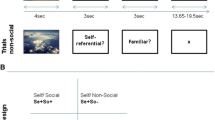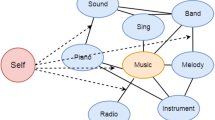Abstract
A prevalent explanation for the self-reference effect is that self-knowledge is represented by a set of specific brain regions, including anterior cingulate cortex (ACC), middle frontal gyrus (MFG), superior temporal gyrus (STG), precuneus, and inferior parietal lobule (IPL), which enables self-knowledge to be processed in priority than other-knowledge. However, the conventional univariate activation analysis adopted by previous studies could only detect the activation of separate brain regions. The current study mainly investigated the global neural patterns of self-knowledge (relative to other-knowledge) by the multivariate pattern analysis (MVPA). Results obtained in Experiments 1 and 2 were highly consistent, indicating that the core self-network (mainly the ACC) and salience network (mainly the insula) could distinguish self-knowledge from other-knowledge. Furthermore, the neural pattern of positive self-knowledge mainly included the ventral part of ACC, while the neural pattern of negative self-knowledge mainly included the ventral and dorsal parts of ACC and cognitive control network (dorsolateral prefrontal cortex: dlPFC). These findings suggest that the core self-network and salience network are specific to the neural process of self-knowledge. Moreover, both positive and negative self-knowledge are separately driven by different cognitive and neural characteristics.




Similar content being viewed by others
References
Alicke, M. D., & Sedikides, C. (2009). Self-enhancement and self-protection: What they are and what they do. European Review of Social Psychology, 20(1), 1–48.
Araujo, H. F., Kaplan, J., & Damasio, A. (2013). Cortical midline structures and autobiographical-self processes: An activation-likelihood estimation meta-analysis. Frontiers in Human Neuroscience. https://doi.org/10.3389/fnhum.2013.00548
Baumeister, R. F., Bratslavsky, E., Finkenauer, C., & Vohs, K. D. (2001). Bad is stronger than good. Review of General Psychology, 5(4), 323–370.
Beer, J. S., & Hughes, B. L. (2010). Neural systems of social comparison and the above-average effect. NeuroImage, 49(3), 2671–2679. https://doi.org/10.1016/j.neuroimage.2009.10.075
Bradley, A. P. (1997). The use of the area under the ROC curve in the evaluation of machine learning algorithms. Pattern Recognition, 30(7), 1145–1159.
Buhrmester, M. D., Blanton, H., & Swann, W. B., Jr. (2011). Implicit self-esteem: Nature, measurement, and a new way forward. Journal of Personality and Social Psychology, 100(2), 365–385. https://doi.org/10.1037/a0021341
Cawley, G. C., & Talbot, N. L. (2004). Fast exact leave-one-out cross-validation of sparse least-squares support vector machines. Neural Networks, 17(10), 1467–1475.
Coopersmith, S. (1967). The antecedents of self-esteem. Freeman.
Dale, A. M., & Buckner, R. L. (1997). Selective averaging of rapidly presented individual trials using fMRI. Human Brain Mapping, 5(5), 329–340.
Denny, B. T., Kober, H., Wager, T. D., & Ochsner, K. N. (2012). A meta-analysis of functional neuroimaging studies of self- and other judgments reveals a spatial gradient for mentalizing in medial prefrontal cortex. Journal of Cognitive Neuroscience, 24(8), 1742–1752.
Ditto, P. H., & Lopez, D. F. (1992). Motivated skepticism: Use of differential decision criteria for preferred and nonpreferred conclusions. Journal of Personality and Social Psychology, 63(4), 568.
Dufner, M., Gebauer, J. E., Sedikides, C., & Denissen, J. J. A. (2019). Self-enhancement and psychological adjustment: A meta-analytic review. Personality and Social Psychology Review, 23(1), 48–72. https://doi.org/10.1177/1088868318756467
Fan, L., Li, H., Zhuo, J., Zhang, Y., Wang, J., Chen, L., & Jiang, T. (2016). The human brainnetome atlas: A new brain atlas based on connectional architecture. Cerebral Cortex, 26(8), 3508–3526. https://doi.org/10.1093/cercor/bhw157
Flynn, F. G. (1999). Anatomy of the insula functional and clinical correlates. Aphasiology, 13(1), 55–78.
Gillihan, S. J., & Farah, M. J. (2005). Is self special? A critical review of evidence from experimental psychology and cognitive neuroscience. Psychological Bulletin, 131(1), 76–97. https://doi.org/10.1037/0033-2909.131.1.76
Haynes, J. D., & Rees, G. (2006). Decoding mental states from brain activity in humans. Nature Reviews Neuroscience, 7(7), 523–534. https://doi.org/10.1038/nrn1931
Hu, C., Di, X., Eickhoff, S. B., Zhang, M., Peng, K., Guo, H., & Sui, J. (2016). Distinct and common aspects of physical and psychological self-representation in the brain: A meta-analysis of self-bias in facial and self-referential judgements. Neuroscience and Biobehavioral Reviews, 61, 197–207. https://doi.org/10.1016/j.neubiorev.2015.12.003
Hughes, B. L., & Beer, J. S. (2012). Orbitofrontal cortex and anterior cingulate cortex are modulated by motivated social cognition. Cerebral Cortex, 22(6), 1372–1381. https://doi.org/10.1093/cercor/bhr213
Izuma, K., Kennedy, K., Fitzjohn, A., Sedikides, C., & Shibata, K. (2018). Neural activity in the reward-related brain regions predicts implicit self-esteem: A novel validity test of psychological measures using neuroimaging. Journal of Personality and Social Psychology, 114(3), 343–357. https://doi.org/10.1037/pspa0000114
Jimura, K., & Poldrack, R. A. (2012). Analyses of regional-average activation and multivoxel pattern information tell complementary stories. Neuropsychologia, 50(4), 544–552.
Kaplan, J. T., Man, K., & Greening, S. G. (2015). Multivariate cross-classification: Applying machine learning techniques to characterize abstraction in neural representations. Frontiers in Human Neuroscience, 9, 151.
Kelley, W. M., Macrae, C. N., Wyland, C. L., Caglar, S., Inati, S., & Heatherton, T. F. (2002). Finding the self? An event-related fMRI study. Journal of Cognitive Neuroscience, 14(5), 785–794.
Kim, M. J., Loucks, R. A., Palmer, A. L., Brown, A. C., Solomon, K. M., Marchante, A. N., & Whalen, P. J. (2011). The structural and functional connectivity of the amygdala: From normal emotion to pathological anxiety. Behavioural Brain Research, 223(2), 403–410.
Klein, S. B., Chan, R. L., & Loftus, J. (1999). Independence of episodic and semantic self-knowledge: The case from autism. Social Cognition, 17(4), 413–436.
Klein, S. B., Loftus, J., & Kihlstrom, J. F. (1996). Self-knowledge of an amnesic patient: Toward a neuropsychology of personality and social psychology. Journal of Experimental Psychology: General, 125(3), 250.
Klein, S. B., Loftus, J., & Kihlstrom, J. F. (2002). Memory and temporal experience: The effects of episodic memory loss on an amnesic patient’s ability to remember the past and imagine the future. Social Cognition, 20(5), 353–379.
Kunda, Z. (1990). The case for motivated reasoning. Psychological Bulletin, 108(3), 480–498. https://doi.org/10.1037/0033-2909.108.3.480
Leary, M. R., Tate, E. B., Adams, C. E., Batts Allen, A., & Hancock, J. (2007). Self-compassion and reactions to unpleasant self-relevant events: The implications of treating oneself kindly. Journal of Personality and Social Psychology, 92(5), 887.
Legrand, D., & Ruby, P. (2009). What is self-specific? Theoretical investigation and critical review of neuroimaging results. Psychological Review, 116(1), 252.
Liu, F., Xie, B., Wang, Y., Guo, W., Fouche, J.-P., Long, Z., & Duan, X. (2015). Characterization of post-traumatic stress disorder using resting-state fMRI with a multi-level parametric classification approach. Brain Topography, 28(2), 221–237.
McDuff, S. G., Frankel, H. C., & Norman, K. A. (2009). Multivoxel pattern analysis reveals increased memory targeting and reduced use of retrieved details during single-agenda source monitoring. Journal of Neuroscience, 29(2), 508–516.
Misaki, M., Kim, Y., Bandettini, P. A., & Kriegeskorte, N. (2010). Comparison of multivariate classifiers and response normalizations for pattern-information fMRI. NeuroImage, 53(1), 103–118.
Moran, J. M., Macrae, C. N., Heatherton, T. F., Wyland, C. L., & Kelley, W. M. (2006). Neuroanatomical evidence for distinct cognitive and affective components of self. Journal of Cognitive Neuroscience, 18(9), 1586–1594.
Murray, R. J., Debbane, M., Fox, P. T., Bzdok, D., & Eickhoff, S. B. (2015). Functional connectivity mapping of regions associated with self- and other-processing. Human Brain Mapping, 36(4), 1304–1324. https://doi.org/10.1002/hbm.22703
Murray, R. J., Schaer, M., & Debbane, M. (2012). Degrees of separation: A quantitative neuroimaging meta-analysis investigating self-specificity and shared neural activation between self- and other-reflection. Neuroscience and Biobehavioral Reviews, 36(3), 1043–1059. https://doi.org/10.1016/j.neubiorev.2011.12.013
Northoff, G., & Bermpohl, F. (2004). Cortical midline structures and the self. Trends in Cognitive Sciences, 8(3), 102–107.
Pereira, F., Mitchell, T., & Botvinick, M. (2009). Machine learning classifiers and fMRI: A tutorial overview. NeuroImage, 45(1), S199–S209. https://doi.org/10.1016/j.neuroimage.2008.11.007
Pratto, F., & John, O. P. (1991). Automatic vigilance: The attention-grabbing power of negative social information. Journal of Personality and Social Psychology, 61(3), 380.
Qin, P. M., Liu, Y. J., Shi, J. F., Wang, Y. Z., Duncan, N., Gong, Q. Y., & Northoff, G. (2012). Dissociation between anterior and posterior cortical regions during self-specificity and familiarity: A combined fMRI-meta-analytic study. Human Brain Mapping, 33(1), 154–164. https://doi.org/10.1002/hbm.21201
Rigney, A. E., Koski, J. E., & Beer, J. S. (2018). The functional role of ventral anterior cingulate cortex in social evaluation: Disentangling valence from subjectively rewarding opportunities. Social Cognitive and Affective Neuroscience, 13(1), 14–21. https://doi.org/10.1093/scan/nsx132
Schaafsma, S. M., Pfaff, D. W., Spunt, R. P., & Adolphs, R. (2015). Deconstructing and reconstructing theory of mind. Trends in Cognitive Sciences, 19(2), 65–72. https://doi.org/10.1016/j.tics.2014.11.007
Sedikides, C. (1993). Assessment, enhancement, and verification determinants of the self-evaluation process. Journal of Personality and Social Psychology, 65(2), 317–338. https://doi.org/10.1037/0022-3514.65.2.317
Sedikides, C., Gaertner, L., & Cai, H. J. (2015). On the panculturality of self-enhancement and self-protection motivation. In A. J. Elliot (Ed.), Advances in motivation science (Vol. 2, pp. 185–241). Elsevier.
Sharot, T., Riccardi, A. M., Raio, C. M., & Phelps, E. A. (2007). Neural mechanisms mediating optimism bias. Nature, 450(7166), 102–105.
Soon, C. S., Brass, M., Heinze, H.-J., & Haynes, J.-D. (2008). Unconscious determinants of free decisions in the human brain. Nature Neuroscience, 11(5), 543–545.
Sorrentino, R. M., Short, J.-A.C., & Raynor, J. O. (1984). Uncertainty orientation: Implications for affective and cognitive views of achievement behavior. Journal of Personality and Social Psychology, 46(1), 189.
Strube, M. J., & Roemmele, L. A. (1985). Self-enhancement, self-assessment, and self-evaluative task choice. Journal of Personality and Social Psychology, 49(4), 981.
Sui, J., & Gu, X. (2017). Self as object: Emerging trends in self research. Trends in Neurosciences, 40(11), 643–653. https://doi.org/10.1016/j.tins.2017.09.002
Sui, J., Rotshtein, P., & Humphreys, G. W. (2013). Coupling social attention to the self forms a network for personal significance. Proceedings of the National Academy of Sciences, 110(19), 7607–7612.
Symons, C. S., & Johnson, B. T. (1997). The self-reference effect in memory: A meta-analysis. Psychological Bulletin, 121(3), 371–394. https://doi.org/10.1037/0033-2909.121.3.371
Taylor, S. E. (1991). Asymmetrical effects of positive and negative events: The mobilization-minimization hypothesis. Psychological Bulletin, 110(1), 67.
Tian, L., Wang, J., Yan, C., & He, Y. (2011). Hemisphere-and gender-related differences in small-world brain networks: A resting-state functional MRI study. NeuroImage, 54(1), 191–202.
Trope, Y. (1982). Self-assessment and task performance. Journal of Experimental Social Psychology, 18(2), 201–215.
Trope, Y. (1986). Testing self-enhancement and self-assessment theories of achievement-motivation—a reply. Motivation and Emotion, 10(3), 247–261. https://doi.org/10.1007/bf00992319
Trope, Y., & Neter, E. (1994). Reconciling competing motives in self-evaluation: The role of self-control in feedback seeking. Journal of Personality and Social Psychology, 66(4), 646.
van der Meer, L., Costafreda, S., Aleman, A., & David, A. S. (2010). Self-reflection and the brain: A theoretical review and meta-analysis of neuroimaging studies with implications for schizophrenia. Neuroscience and Biobehavioral Reviews, 34(6), 935–946. https://doi.org/10.1016/j.neubiorev.2009.12.004
Van Overwalle, F. (2009). Social cognition and the brain: A meta-analysis. Human Brain Mapping, 30(3), 829–858. https://doi.org/10.1002/hbm.20547
Yan, C., & Zang, Y. (2010). DPARSF: A MATLAB toolbox for pipeline data analysis of resting-state fMRI. Frontiers in Systems Neuroscience, 4, 13.
Acknowledgements
We are grateful to Xiaolin Zhao, Weiyu Hu, Yang He, Xuehan Zhang, Huixiang Li, Yadong Liu, Mengxue Lan, Mengning Zhang, and Nan Wang for providing writing assistance and proof reading.
Funding
This work was supported by the National Natural Science Foundation of China [31971019], Chongqing Research program of Basic Research and Frontier Technology [cstc2019jcyjmsxmX0016], and Fundamental Research Funds for the Central Universities [SWU2009202].
Author information
Authors and Affiliations
Contributions
JY: writing (review and editing), conceptualization, formal analysis. HC: writing (original draft), conceptualization, formal analysis. JL: conceptualization, formal analysis. MZ: conceptualization, formal analysis.
Corresponding author
Ethics declarations
Conflict of Interest
The authors declare that they have no conflict of interest.
Ethical approval
All procedures performed in studies involving human participants were in accordance with the ethical standards of the institutional and/or national research committee and with the 1964 Helsinki declaration and its later amendments or comparable ethical standards.
Informed consent
Informed consent was obtained from all individual participants included in the study.
Research involving human and animal participants
This article does not contain any studies with animals performed by any of the authors.
Additional information
Publisher's Note
Springer Nature remains neutral with regard to jurisdictional claims in published maps and institutional affiliations.
Appendix
Rights and permissions
About this article
Cite this article
Chen, H., Li, J., Zeng, M. et al. Neural decoding of positive and negative self-knowledge. Motiv Emot 45, 585–598 (2021). https://doi.org/10.1007/s11031-021-09900-7
Accepted:
Published:
Issue Date:
DOI: https://doi.org/10.1007/s11031-021-09900-7




